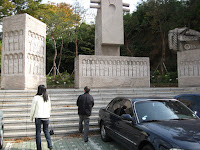
I spent today with older Mr Lee and Miss Cho at the Yanghwajin Foreign Missionary Cemetery in Hapjeong-dong and two attached sites--a Catholic Museum and shrine, and an interpretive center. Catholicism in Korea stretches back to 1784, and was quickly followed by the first execution of Catholics in 1801. The Catholic museum is at a site called Chol Tu San, "Hill of Beheading", where unknown thousands of Korean Christians were martyred in the 1866 Byungin Massacre.

The episode began with the murder of nine French missionaries. The French government sent two navy ships up the Hangang to the fortress at Yanghwajin, "Willow Flower Fortress" to get to the bottom of the events. At the time, Korea was ruled by the Regent Tae Won-gun, father of the teenage King Kojong (who would eventually come to be known as the last king of Chosun). The French ships were turned back, and Tae Won-gun cleansed the site with the blood of Christians. The site documents torture and persecution of Korean Christians throughout the 1800s.
 |  |
 |  |
In addition to the museum, the catholic shrine has a statuary park which includes a really neat outdoor Stations of the Cross and a big memorial to the martyrs.
 | |
 |  |
 |  |
 |  |
 |  |
The Foreign Missionary Cemetery was first opened in 1885, and is the resting place of several influential foreigners, including newspaperman Ernest Bethell, whose reporting tried to rally the West against the brutal Japanese occupation beginning 1905, and US diplomat Homer Hulbert, whose epitaph reads, "I would rather be buried in Korea than in Westminster Abbey." There is a very nice, media-intensive interpretive center. The first picture below asks visitors to use their hands to hold up the names of Protestant missionaries.
 |  |
 |  |
That bottom right photo is of Fifteen Years Among the Top-Knots by Horace Underwood, one of the earliest and most influential missionaries. In fact, the Underwood family served in Korea (and many are buried here) for four generations and 119 years, finally leaving in 2004. Underwood, a Presbyterian, founded what became Yonsei University, one of Korea's top three. Another Presbyterian missionary, Mary Scranton, founded Ehwa Women's University.


On this lovely autumn day, the cemetery was beautiful in its setting amid the turning trees and a crisp blue sky. But not too long ago, it had fallen into serious disrepair, and efforts of the Union Church (Protestant non-denominational), to which Mr Lee belongs, took ten years to bring it to its present state. Finally, here is a namesake Scottish missionary:
 |  |










No comments:
Post a Comment